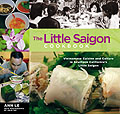 Last week was all about cooking. My sister was in London, which meant I was able to work on the Dalat Pork Ragu recipe for Communion. (Julie doesn't eat pork or beef.) And because I was invited to Ann Le's holiday party—cookies required for entry—I took the excuse and baked not only two batches of cookies, but two batches of crackers (cracker recipes to come in the next post), as well.
Last week was all about cooking. My sister was in London, which meant I was able to work on the Dalat Pork Ragu recipe for Communion. (Julie doesn't eat pork or beef.) And because I was invited to Ann Le's holiday party—cookies required for entry—I took the excuse and baked not only two batches of cookies, but two batches of crackers (cracker recipes to come in the next post), as well.For the cookies, I went for an old favorite, Ginger Cookies from my mom’s hand-me-down Betty Crocker’s Cookbook, and tried a new recipe: Tea and Honey Crisps from this month’s Gourmet. I love the Ginger Cookie recipe. It calls for shortening, like all traditional Betty Crocker recipes do, and when you mix it, the texture is satisfyingly creamy, resulting in a finished product that is just the right degree of chewy. As for the Tea and Honey Crisps, I wouldn’t make them every day (they’re very sweet and their flavor is strong), but they are definitely a good choice for a special occasion, such as a Sunday brunch or afternoon tea.
Ginger Cookies
from Betty Crocker’s Cookbook
Ingredients:
- 1 cup brown sugar (packed)
- 1 egg
- ¼ cup molasses
- ¾ cup shortening
- 1 tsp cinnamon
- 1 tsp ginger
- ½ tsp cloves
- ¼ tsp salt (I use sea salt, because I like the contrast of salt with the sweet of the molasses)
- 2 ¼ cups flour (if self-rising, decrease baking soda to 1 tsp)
- 2 tsp soda
- Granulated sugar
Directions:
1. Mix brown sugar, egg, and molasses in a large mixing bowl.
2. Blend in the shortening and stir until mixture is creamy.
3. Stir in the rest of the ingredients, except granulated sugar.
4. Cover and chill for one hour.
5. Spoon into rounded balls about one inch in diameter. Dip balls in sugar.
6. Bake at 375 degrees on a lightly greased cookie sheet for 10-12 minutes. Beware of overcooking. You don’t want little ginger rocks.
Note: I use parchment paper so I don’t have to grease the cookie sheet.
Makes approximately 40 cookies.
**********
Tea-and-Honey Crispsadapted from Gourmet, December 2006
Ingredients:
- 1 stick (½ cup) unsalted butter, softened
- 1 cup confectioners sugar
- ¼ cup honey
- 2 tsp decaffeinated Earl Grey tea leaves (2 tea bags)
- 2 large egg whites
- 1 cup all-purpose flour
Directions:
1. Beat together butter, powdered sugar, honey, and tea leaves in a large bowl with an electric mixer at medium speed until combined well.
2. Add egg whites 1 at a time, beating well after each addition.
3. Reduce speed to low, then mix in flour until just combined.
4. Line a cookie sheet with parchment paper. Spread dough in a 1 ½-inch circle, 1/8-inch thick. Keep at least half an inch between cookies.
5. Bake until edges are deep golden brown, approximately 15 minutes. (Start checking on the cookies after 10 minutes.)
6. Let cookies cool on the sheet, then transfer with spatula to a rack to cool completely.
Tea note: I used regular Earl Grey, and it seemed to work fine. Also, if you’re using loose tea, make sure to crush it fine.
Stencil note: The Gourmet recipe calls for making your own stencils out of Styrofoam plates. I just spread the dough on the parchment paper in rounds as described above. This worked fine.
Baking time note: The Gourmet recipe also calls for a cooking time of 6-9 minutes. I had to cook mine for about 15 minutes. Otherwise, they were mushy.
Makes about 80 cookies. Guess what time of year it is? I just peeled 30 lemons, and the rinds are soaking in Everclear. If you have access to ripening lemons, it’s time to get started on your limoncello for spring gift giving. Friends are already asking when mine is going to be ready … they wiped out last year’s batch, and are rapidly making their way through my winter store of nocino.
Guess what time of year it is? I just peeled 30 lemons, and the rinds are soaking in Everclear. If you have access to ripening lemons, it’s time to get started on your limoncello for spring gift giving. Friends are already asking when mine is going to be ready … they wiped out last year’s batch, and are rapidly making their way through my winter store of nocino.








